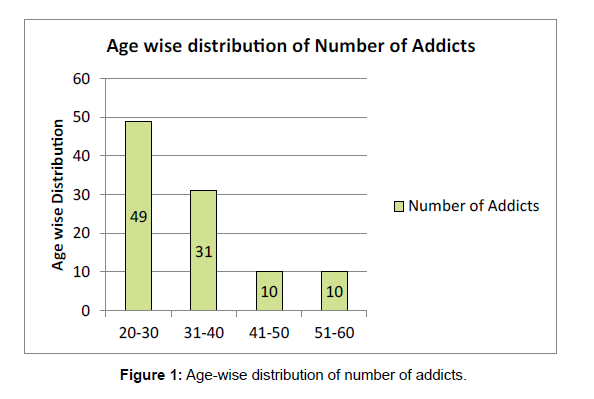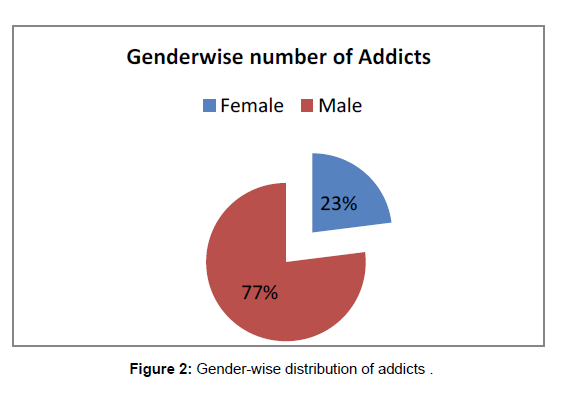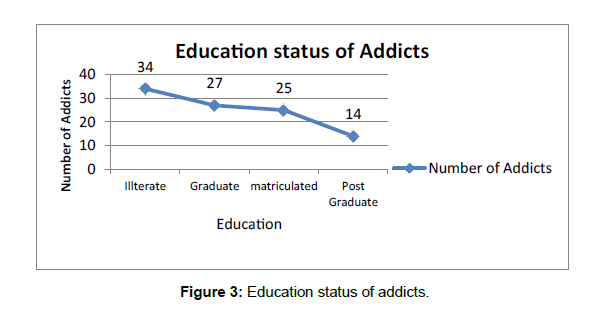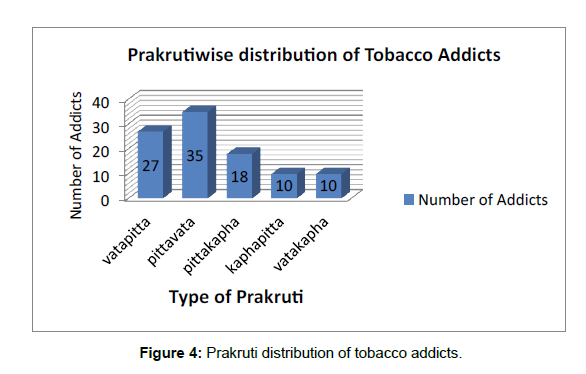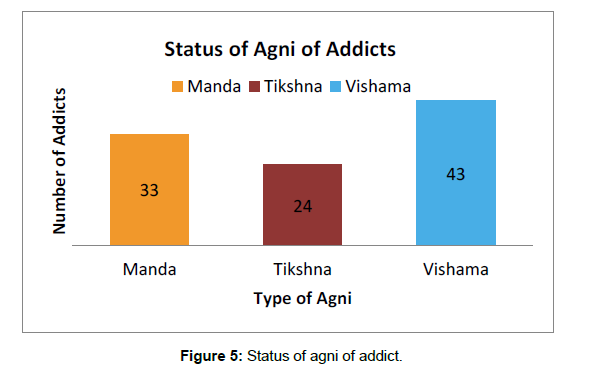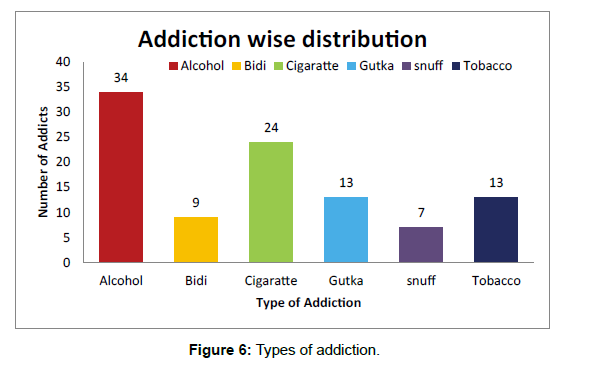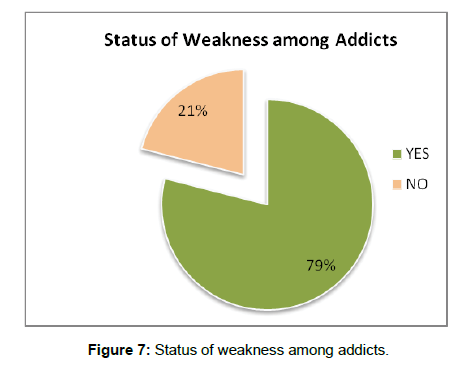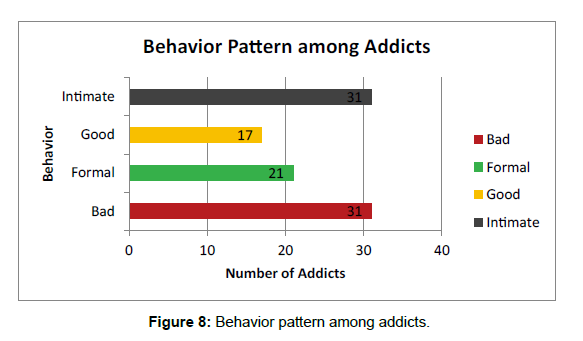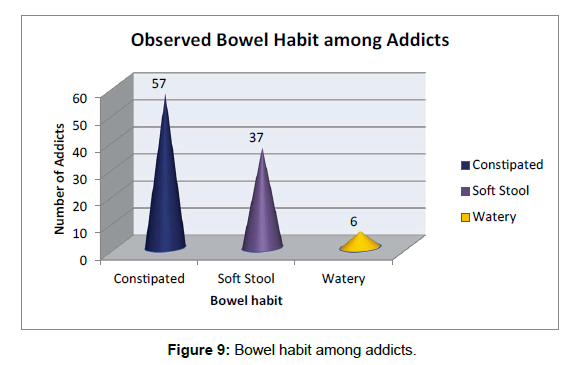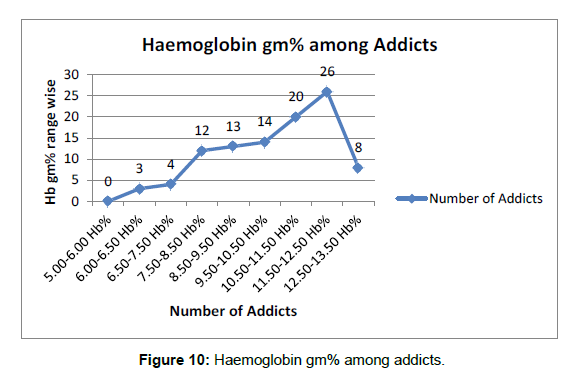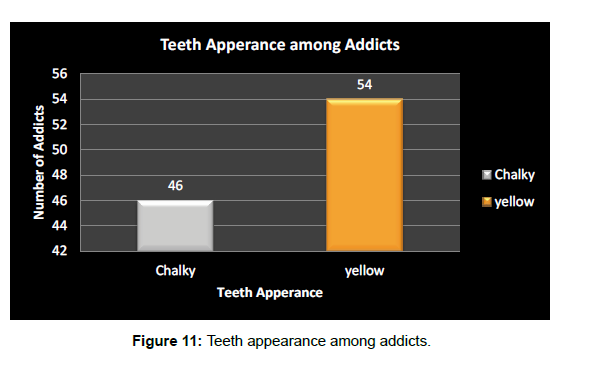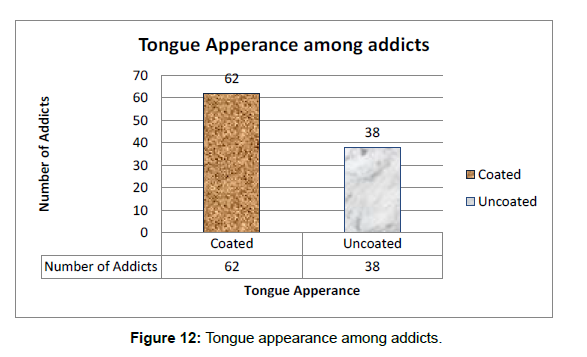Assessment of Addiction and Tobacco Abuse variants use in rural community Ratnapur village of Wardha district- Occupational and Community Survey
Received: 16-Apr-2022 / Manuscript No. omha-22-61046 / Editor assigned: 19-Apr-2022 / PreQC No. omha-22-61046 (PQ) / Reviewed: 04-May-2022 / QC No. omha-22-61046 / Revised: 09-May-2022 / Manuscript No. omha-22-61046 (R) / Published Date: 16-May-2022 DOI: 10.4172/2329-6879.1000406
Abstract
Background: Addiction means compulsive physiological need for and use of a habit-forming substance (like heroin or nicotine), characterized by tolerance and well-defined physiological symptoms upon withdrawal; it has also been used more broadly to refer to compulsive use of a substance known by the user to be dependant. Early age is more prone to various addictions may help to mitigate sufferings and health problems. With this background, this study was conducted in a small village of Wardha district.
Aims and Objectives: The aims of this work were to assess the age of onset of addiction, to asses substance of different forms of tobacco, to compare number of males and females having different forms tobacco addictions. To assess different types of health problems associated with tobacco addictions and to study the cause of addiction.
Materials and Methods: A community-based cross-sectional study was conducted among villagers in the age group 20–60 years, who were personally interviewed based on a predesigned structured questionnaire. Data for this survey were collected by house-to-house visits using a structured questionnaire through interviewing and observation during Community Health Check Program from Mahatma Gandhi Ayurveda College, Hospital & Research Centre.
Results: Age of onset of addiction started in early age between 20 and 30 years. 77% females were addicted to various addicted variants. Illiterate peoples are more addicts. 35 addicts of pitta-Vaat prakruti were more prone to addiction. 34% people were addicted to alcohol maximum seen in village but frequency of tobacco chewing maximum were seen. Main source of addiction among addicts was 38% are their friends. Health problems like mouth ulcers are mostly seen. 41% addicts were experienced restlessness. Bad and Intimate behaviour also were mostly seen among 31% addicts. Main cause of addiction among Ratnapur village is illiteracy and source of addiction is friends.
Conclusion: Many are unaware about the percentage of addiction are more among illiteracy and bad company like friends. There is a need to create awareness among villagers about addiction among teenagers and counselling with respect to rehabilitation.
Keywords
Introduction
The developing scenario of science and technology has moved the world to greater heights but at the same time infliction towards a thing as a habit has created lots of problems in individuals especially with regard to their health. The young generation has fallen prey of many such things the most important being act of addiction. Addiction is a primary, chronic disease of brain reward, motivation, memory and related circuitry. Dysfunction in these circuits leads to characteristic biological, psychological, social and spiritual manifestations. This is reflected in an individual pathologically pursuing reward and/or relief by substance use and other behaviours. Addiction is characterized by inability to consistently abstain, impairment in behavioural control, craving, diminished recognition of significant problem with one’s behavioural and interpersonal relationship, and dysfunctional emotional response. In India addiction among youngsters is a big problem. Major addictions are Tobacco Abuse According to World Health Organization (WHO) estimates, globally, there were 100 million premature deaths due to tobacco in the 20th century, and if the current trend of tobacco use continues, this number is expected to rise to One billion in the 21st century [1]. Tobacco attributable mortality rate among Indian men and women from the Mumbai cohort study were studided based on these estimates, nearly 23.7% of the deaths among men (527,500) and 5.7% of the deaths among women (83,000) aged 35–69 years are due to tobacco-attributable illnesses [2].
‘In India 1 million deaths in a year will be attributable to smoking by the early 2010s’ [3]; and cohort study in 2010 from southern India reported mortality risks of 0.98 (0.86–0.94) and 1.22 [1.04–1.44] for allcause and tobacco-related cancer mortality, respectively, for tobacco chewing, while with smoking, the respective mortality risks were 1.31[1.24–1.39] and 1.68 [1.36–2.08] [4].
In a cohort from Mumbai it was found that the incidence of oral cancers was 42% higher among bidi smokers as compared with cigarette smokers [5].
The Gutka chewing according to Global Adult Tobacco Survey, 53.5% of Indians use tobacco products [66.2% of men and 40% of women]. Tobacco and Gutka chewing makes up the majority of those figures with 48.07% of Indians using them, while bidis and cigarette smokers make up 8.4% and 5.9% of the population respectively [6].
In 2008, about 5 million children under 15 were addicted to Gutka. A survey in Uttar Pradesh and Madhya Pradesh found precursors of mouth cancers in 16% of the children [7]. Smoking addiction leads to smoke, which causes type 2 diabetes mellitus and can make it harder to control. The risk of developing diabetes is 30–40% higher for active smokers than non-smokers [8].
In cohort study it is observed effect of obesity over the liver is more as compared to that of addiction as they share a common Pathphysiology. Treating alcohol use disorder in obese patients with liver disease and obesity will be integral to the patients, with liver disease and obesity will be integrated to the management of these patients. Alcohol use disorder and non-alcoholic steato-hepatitis will be the most common aetiologies for end-stage liver disease [9].
Genetic and environmental plays a very significant in pathogenesis and progression of alcoholic liver disease, epigenetic changes interact with genetic modifiers thus, there is increasing individual susceptibility to alcoholic Liver Disease, now a days the most preferred line of treatment for such conditions are- corticosteroids, prednisolone, phtoxifylline, or liver transplantation with respect to the severity of the disease. Micro-RNAs have an appealing molecules candidate for diagnosis and staging of liver diseases and their combination with genetic profile will promote the development of novel personalised therapeutic approaches [10]. Environmental ,Genetic, Metabolic and Behavioural factors that influence restitution of neurofunction are to be identified but are amenable to study with neuroimaging, the scope and limit of the brain’s plasticity at different ages of alcohol exposure and withdrawal, and insight into neural mechanism of insult and recovery [11].
The prevalence of depression among alcohol dependent persons is high, person who are depressed have a significantly higher craving for alcohol after detoxification and rehabilitation.
The Relationship of alcohol addiction and depression and cooccurrence is at prevalence rate of 16%–68%, Studies reported that depressed and non-depressed alcohol-dependent persons with particular focus on the participant's psychic level of alcohol dependence, demographic characteristics, or illness-related variables [12].
Tobacco and its variants
It is the most common form of addiction one could see especially in India among Male, Females, and Children it is generally consumed in various forms as shown in Table 1.
| S.no | Tobacco and its froms |
|---|---|
| 1 | Cigarette - Most common and most harmful |
| 2 | Bidi – most commonly used form in India |
| 3 | Cigar |
| 4 | Hookah (Hubble bubble) |
| 5 | Sheesha |
| 6 | Tobacco chewing |
| 7 | Kreteks (clove cigarettes) |
| 8 | Snuff – Moist & Dry |
| 9 | E-cigarette – recent intruder in the list |
Table 1: Tobacco and its variants.
This mixture is a combination of 4,000 chemicals of which at least 40 are carcinogenic compounds, say doctors. “Overall, people can develop cancers of mouth, throat, lung and oesophagus; heart disease and related ailments. While most youngsters get easily addicted to it, women are in the habit of chewing tobacco or even inhaling snuff, which is even more harmful,” adds Dr. Tri .Smoking was associated with excess deaths among smokers between 30 and 69 years, mainly from tuberculosis and also from respiratory, vascular or neo-plastic disease. The harms caused by inhalation of poisonous chemicals such as Carbon Monoxide in tobacco smoke include diseases affecting the heart and lungs, with smoking being a major risk factor for heart attacks, strokes, chronic obstructive pulmonary disease, emphysema, and cancer (particularly lung cancer, cancers of the larynx and mouth, and pancreatic cancers). Cancer is caused by inhaling carcinogenic substances, Gutka is a preparation of crushed areca nut, tobacco, catechu paraffin wax, slaked lime and sweet or savoury flavourings .Drinking too much can weaken your immune system, making your body a much easier target for disease. Chronic drinkers are more liable to contract diseases like pneumonia and tuberculosis than people who do not drink too much. Drinking a lot on a single occasion slows your body’s ability to ward off infections – even up to 24 hours after getting drunk. Bidi is a cheap smoking stick, handmade by rolling a dried, rectangular piece of timbering leaf (Diospyros melanaxylon) with 0.15–0.25 g of sun-dried, flaked tobacco filled into a conical shape and the roll is secured with a thread. The length of a bidi varies from 4.0–7.5 cm. Bidi’s are commercially available in small packets. Hooka (a Hubble bubble Indian pipe) is an indigenous device, made out of wooden and metallic pipes, used for smoking tobacco. The tobacco smoke passes through water kept in a spherical receptacle, in which some aromatic substances may also be added. Hooka smoking is a common method of socializing among the people. Chhutta is a coarsely prepared roll of tobacco (cheroot), smoked with the burning end inside the mouth (reverse chhutta smoking). Its use is prevalent in coastal areas of the province of Andhra Pradesh in south-eastern India. Dhumti is a cigar-like product made by rolling tobacco leaves inside the leaf of jackfruit tree. Occasionally, dried leaf of a banana plant is used. Males smoke dhumti in conventional manner, whereas females smoke it in a reverse manner, i.e. keeping the burning end inside the mouth. Dhumti smoking is quite popular in the Goa province of the Western India. Hookli is a short clay pipe-like device, being about 7 cm long, and is used for smoking tobacco in some parts of the country. Chillum is a conical clay-pipe of about 10 cm long. The narrow end is put inside the mouth, often wrapped in a wet cloth that acts as a filter. This is used to smoke tobacco alone or tobacco mixed with ganja (marijuana) in northern parts of the country. Especially in the Northern and Eastern parts of India, and is a part of the rural cultural life. Its use is more common among the adults and older generation. However, it is not popular among adolescents, because the adults generally discourage younger population from using hooka.
Smoking can also affect men's sperm, which can reduce fertility and also increase risks for birth defects and miscarriage. Smoking affects the health of your teeth and gums and can cause tooth loss. Smoking can increase your risk for cataracts (clouding of the eye’s lens that makes it hard for you to see) and age-related macular degeneration (damage to a small spot near the centre of the retina, the part of the eye needed for central vision). Smoking causes general adverse effects on the body:-
• Inflammation and decreased immune function.
• Smoking is a cause of rheumatoid arthritis.
• Cervix
• Colon and rectum (colorectal)
• Oesophagus
• Kidney and ureter
• Larynx
• Liver
• Oro-pharynx (includes parts of the throat, tongue, soft palate, and the tonsils)
• Pancreas
• Stomach
• Trachea, bronchus, and lung Smoking can make it harder for a woman to become pregnant and can affect her baby's health before and after birth. Smoking increases risks for:
• Preterm (early) delivery
• Stillbirth (death of the baby before birth)
• Low birth weight
• Sudden infant death syndrome (known as SIDS or crib death)
• Ectopic pregnancy
• Oro-facial clefts in infants
Materials and Methods
A standard questionnaire comprising of open and close ended questions was prepared. A community-based observational study was conducted among civilians residing in the in Wardha district. All males and females in the age group of 15 to 40 years were personally interviewed on the basis of predesigned structured open and close ended questionnaires from August 2018 to December 2018. Data were analyzed statistically by simple proportions. Ethical clearance and permission were obtained from the Institutional Ethical Committee (IEC), DMIMS (Deemed-to-be University), Sawangi (Meghe), Wardha. Permission was secured through a formal letter with Ref. No. DMIMS (DU)/IEC/2018- 19/7201. Before interviewing, a verbal consent of the respondent was taken.
Sample size
This study included a sample size of 100 villagers residing Ratnapur village.
Inclusion criteria
The inclusion criteria of the study included all girls between the age group of 12 and 19 years residing in Ratnapur (rural area) of Wardha district.
Observations and Results
Observation is noted and presented in the form of tables. During the survey, 100 both either in the age group of 20–60 years were interviewed, and their responses were collected as shown in Table 2.
In this study most of age group 20-30 addicts 46 respondents are seen (Figure 1). 31-40 addicts 31 respondents. 41-50 addicts 10 respondents, 51-60 addicts 10 respondents.
In this study 49 age wise addicts are seen mostly in age of 20-30 years age group this is mostly onset of addiction (Figure 2).
In this study 77% Males are mostly seen prone to addition due to easy availability of addiction variants (Figure 3).
The 34 addicted peoples are Illiterate. 27 are Graduates, 25 are matriculated, and 14 are Post Graduate. The addiction is more prevalent among illiterate peoples.
In this study, it is observed see Table 3 that mostly 35 addicts are seen of pittavaat prakruti, 21 are pittakapha prakruti, 18 are vaatpitta prakruti, 10 are vaatkapha prakruti and kaphavaatprakruti (Figure 4).
| Type of Prakruti | Number of Addicts |
|---|---|
| Vatapitta | 27 |
| Pittavata | 35 |
| Pittakapha | 18 |
| Kaphapitta | 10 |
| Vatakapha | 10 |
Table 3: Types of Prakruti smoked by people resulting in addiction.
It is observed in this study that, 43 addicts with the visham agni, and 33 addicts with mand agni, 24 addicts with tikshna agni (Figure 5).
It is observed that 34 persons were addicted to alcohol. Then cigarette addiction was found in among 24 persons, tobacco chewing addiction found in 13 persons, Gutka chewing addiction was found in 13 persons. Snuffing of substances was found among 7 patients (Figure 6).
Source wise addiction was found in 38 persons are addicted through friends, 26 persons were addicted because of organizations, and 21 persons are addicted because of parents as shown in Table 4.
| Source of Addiction | Number of addicts |
|---|---|
| Friends | 38 |
| Other | 5 |
| Parents | 21 |
| Relatives | 10 |
| Organization | 26 |
Table 4: Source wise addiction.
The 79 addicts experience weakness as shown in Table 5 and 21% no any change in power (Figure 7).
| WeaknessWeakness on Addiction | Number of Addicts | % of Addiction |
|---|---|---|
| YES | 79 | 79 |
| NO | 21 | 21 |
Table 5: Addicts experience weakness.
Behaviour pattern of addicts bad among 31 persons, 31 persons are intimate, formal behaviour seen in 21 and good behaviour seen in 17
In this study 57 addicts are constipated 37 addicts were having soft stools, 6 were having watery stools (Figure 9).
The observed value of Haemoglobin percentage among 26 addicts was highest in range of 11.50-12.50 gm% lowest in 20 addicts in range of 10.50-11.50gm%, 14 addicts in range of 9.50-10.50 gm% (Figure 10).
In this study 65 addicts were recorded blood pressure ranges 150- 100 mm of Hg. 24 addicts were recorded blood pressure ranges 130-90 mm of Hg, 11 addicts were recorded blood pressure ranges 120-80 mm of Hg as shown in Table 6.
| Blood Pressure range | Number of addict |
|---|---|
| 120-80 | 11 |
| 130-90 | 24 |
| 150-100 | 65 |
Table 6: Blood pressure ranges among addicts.
Table 6: Blood pressure ranges among addicts.
On examination of addicts pulse rate maximum 51 addicts were seen in 65-70 beats per min, 19 addicts were seen in 60-65 beats per min, 17 addicts were seen in 80-85 beats per min, 8 and 5 addicts were seen in 75-80 &70-75 beats per min as shown in Table 7. Teeth appearance chalky among 46 addicts, 54 addicts were found yellow teeth (Figure 11). Tongue coated appearance were seen among 62 addicts, 38 addicts were found uncoated tongue. Sleep pattern among 41 addicts were seen restless, and 33 addicts seen sound sleep 21 addicts seen loss of sleep, 5 experienced interrupted sleeps as shown in Figure 12. Occupational survey reveals that 65% farmers are more tobacco addicted than Construction worker 13% are addicted, 12% Factory Workers lastly day 10% workers are addicted to different class of additions as shown in Table 8.
| Pulse Rate Range | Number of addict |
|---|---|
| 60-65 | 19 |
| 65-70 | 51 |
| 70-75 | 5 |
| 75-80 | 8 |
| 80-85 | 17 |
Table 7: Pulse rate examination among addicts.
| Occupation | Number of addicts |
|---|---|
| Farmer | 65 |
| Worker | 10 |
| Factory Worker | 12 |
| Construction worker | 13 |
Table 8: Occupation among addicts.
Discussion
It is observed that 34 peoples are illiterate on the other hand 14 are post graduated prone to the addiction. Population with Prakriti of Kaphapitta are 34 in number while, Pittakapha are 18 in number, however, Pittavaat and Vaatkapha are 10in number. Parallel, with the count of Manda Agni holds 33 in count while, Tikshna Agni holds with 24 in count. It is observed that huge number of people stapes up to the addiction due their friends of about 38 in number and 26 were involved into habit due to organisations, while, 21 among them were found to habituated due their parents. It affects the Bala of person as well which goes in count of 79 person found to be weak and 21person among them found with no certain remarkable changes in them. It was even taken to consideration that 31 person were having bad and intimate approach of behaviour.57 person among them were suffering through constipated stools while 37 person among them were having soft stools.26 among them holds with highest range of Haemoglobin with that of 11.50-12.50 gm percent, on the other hand lowest range of haemoglobin with that of 10.50-11.50 gm percent. 46 persons were having chalky teeth while 54 had yellow teeth and 62 among them had coated tongue while, 38 had non-coated tongue.41number of person suffered with restlessness while 33 went into sound sleep however, 21 felt loss of sleep. Occupational survey reveals that 65% farmers are more tobacco addicted.
Conclusion
It should be taken in consideration that ,the way Pathya Ahar leads to Sharira Pushti and Viruddha Ahar leads to Dosha Vruddhi and Dhatu Ksahaya, the same thought of principal shall be taken care of, while administrating, Madya habituation (Alcohol addiction),that having it in proper quantity (as per bala/strength) by person would result as Rasayan. However, Person with Pitta and Vaat Prakriti suffers more with the symptoms as Madya habituation possesses the Pitta and Vaat Pradhan quality. Administration of any of addictives shall only be practised by the person who are good enough with their Bala, to have sustainability for any of Addictives.. And, if you are doing well with the Bala/Strenght, which ultimately means you’re doing well with Agni as well, which is been found Visham in most of Addicted people. And it reflects over the pattern of stools being passed, are constipated in most among them, which clearly reflects, Pachan kriya of a person, is not well, and, these principle of digestion is also, implemented over the way of behaviour with other people of addicted person, which is found to be Intimate or Bad in huge number among, addicted people, in such condition we shall think that, such person are not able to cooperate with people .i.e. not able to carry the thoughts of other person which means they are not able to digest anybodies school of thought, and therefore, they often found carrying tag of bad and intimate behaviour .We should give a thought that, our tongue is reflection of GIT, so, tongue being Aam-janya means mechanism of digestion is not proper, which we found in most of Addicted persons. And as digestion is not proper the saliva in mouth (Bodhak Kaph) isn’t proper with its pH value, which leads to Chalky (mostly observed in the study) and Yellow teeth, here, we shall even think of Tartar deposits on Teethleads Chalky appearance. When we take Ushna Guna(Vyasan Dravya) in consideration which is commonly a found in all addictives, and on other hand on the panchbhautik compositon is Agneya dravya,in such condition it comes to conclusion that Rasa Raktadi dhatu dushti will ultimately lead to Pitta dosha dushti,and these dushit dosha dhatu avastha will get resulted into Restlessness of Sleep. Also, shall take in consideration, dushit pitta, i.e. will lead to increased volume of blood which ultimately leads to exertion of pressure over arterial wall, which is known to be increase of blood pressure, and these pressure will be reflected over pulse rate as well, and also occupations affects the normal texture of system and body functions.
Financial Support and Sponsorship
Datta Meghe Institute of Medical Sciences (DU).
Conflicts of Interest
There are no conflicts of interest.
References
- http://whqlibdoc.who.int/publications/2011/9789240687813_eng.pdf
- Jha P, Jacob B, Gajalakshmi V, Gupta PC, Dhingra N, et al. (2008) A nationally representative case–control study of smoking and death in India. N Engl J Med 358:1137-47.
- Gupta PC, Pednekar MS, Parkin DM, Sankaranarayanan R (2005) Tobacco associated mortality in Mumbai (Bombay) India. Results of the Bombay cohort study. Int J Epidemiol 34:1395-402.
- Ramadas K, Sauvaget C, Thomas G, Fayette JM, Thara S, et al. (2010) Effect of tobacco chewing, tobacco smoking and alcohol on all-cause and cancer mortality: a cohort study from Trivandrum, India. J Cancer Epidemiol 34:405-12.
- Pednekar MS, Gupta PC, Yeole BB, Hébert JR (2011) Association of tobacco habits, including bidi smoking, with overall and site-specific cancer incidence: results from the Mumbai cohort study. Cancer Causes Control 22:859-68.
- Ruhil R (2018) India has reached on the descending limb of tobacco epidemic. Indian J Community Med 43:153.
- Sankhla B, Kachhwaha K, Hussain SY, Saxena S, Sireesha SK, et al. (2018) Genotoxic and carcinogenic effect of gutkha: a fast-growing smokeless tobacco. Addict Health 10:52.
- Maddatu J, Anderson-Baucum E, Evans-Molina C (2017) Smoking and the risk of type 2 diabetes. Transl Res 184:101-7.
- Leggio L, Lee MR (2017) Treatment of alcohol use disorder in patients with alcoholic liver disease. AmJMed 130:124-34.
- Meroni M, Longo M, Rametta R, Dongiovanni P (2018) Genetic and epigenetic modifiers of alcoholic liver disease. Int J Mol Sci 19:3857.
- Sullivan EV, Harris RA, Pfefferbaum A (2010) Alcohol's effects on brain and behavior. Alcohol Res Health 33:127-143.
- Kuria MW, Ndetei DM, Obot IS, Khasakhala LI, Bagaka BM, et al. (2012) The association between alcohol dependence and depression before and after treatment for alcohol dependence. ISRN Psychiatry 2012:1-6,
Indexed at, Google Scholar, Crossref
Indexed at, Google Scholar, Crossref
Indexed at, Google Scholar, Crossref
Indexed at, Google Scholar, Crossref
Indexed at, Google Scholar, Crossref
Indexed at, Google Scholar, Crossref
Indexed at, Google Scholar, Crossref
Indexed at, Google Scholar, Crossref
Indexed at, Google Scholar, Crossref
Citation: Popat D, Mhaiskar B, Chouragade N, Parwe S (2022) Assessment of Addiction and Tobacco Abuse Variants Use in Rural Community Ratnapur Village of Wardha District-Occupational and Community Survey. Occup Med Health 10: 406. DOI: 10.4172/2329-6879.1000406
Copyright: © 2022 Popat D, et al. This is an open-access article distributed under the terms of the Creative Commons Attribution License, which permits unrestricted use, distribution, and reproduction in any medium, provided the original author and source are credited.
Share This Article
Recommended Journals
Open Access Journals
Article Tools
Article Usage
- Total views: 2100
- [From(publication date): 0-2022 - Feb 22, 2025]
- Breakdown by view type
- HTML page views: 1722
- PDF downloads: 378

